Impact of trust on the relationship of e-service quality and customer satisfaction
Added on 2021-08-30
39 Pages11049 Words95 Views
IMPACT OF E-SERVICE QUALITY ON USERS’ LOYALTY: MEDIATING
SATISFACTION AND MODERATING TRUST STUDY
Chapter 1
1.1Introduction
The study focuses on the factors that influence users' satisfaction and trust in the quality of e-
services. The study's background was discussed first, followed by a discussion of the problem
description, the study's objectives, the research gap, and the development of research questions.
Besides that, the research's significance was highlighted. The table format was then used to
convey the definitions of key concepts and variables. The goal of this research is to look into the
several aspects of the quality of e-services that influence loyalty, as well as effects on service
quality and loyalty and their interrelationships. Customized elements affecting service quality
and loyalty intention were proposed using the service quality model.
1.2 Background of the studies
From this point in time, the internet network has become the most important aspects of human
activity because it has made all endeavors much easier. Furthermore, because of the internet's
existence, people's lifestyles are changing (Helvinari et al, 2019). Today's society prefers
improvisational culture, which is a practical and quick way of doing things. As a result, as the
internet becomes more widely used, so does the usage of commerce, one of which is doing
business activities electronically.
Customer satisfaction is critical for every good and services business. E-satisfaction is a term
used to replace client satisfaction in the internet world. E-satisfaction is defined by Rowley
(2006) as the consumer's affective state toward the website as determined by examining all areas
of customer relations. According to Kotler (2016), consumer loyalty is defined as the level of
one's feelings after comparing one's feelings about performance or results to his or her
expectations. Customers will experience satisfaction or dissatisfaction as a result of the
comparison between expectations and performance. The customer will be happy or satisfied if
the performance meets or even surpasses expectations, which will influence client loyalty. In
contrast, if the performance falls short of the customer's expectations, he or she will be
disappointed or unhappy.
SATISFACTION AND MODERATING TRUST STUDY
Chapter 1
1.1Introduction
The study focuses on the factors that influence users' satisfaction and trust in the quality of e-
services. The study's background was discussed first, followed by a discussion of the problem
description, the study's objectives, the research gap, and the development of research questions.
Besides that, the research's significance was highlighted. The table format was then used to
convey the definitions of key concepts and variables. The goal of this research is to look into the
several aspects of the quality of e-services that influence loyalty, as well as effects on service
quality and loyalty and their interrelationships. Customized elements affecting service quality
and loyalty intention were proposed using the service quality model.
1.2 Background of the studies
From this point in time, the internet network has become the most important aspects of human
activity because it has made all endeavors much easier. Furthermore, because of the internet's
existence, people's lifestyles are changing (Helvinari et al, 2019). Today's society prefers
improvisational culture, which is a practical and quick way of doing things. As a result, as the
internet becomes more widely used, so does the usage of commerce, one of which is doing
business activities electronically.
Customer satisfaction is critical for every good and services business. E-satisfaction is a term
used to replace client satisfaction in the internet world. E-satisfaction is defined by Rowley
(2006) as the consumer's affective state toward the website as determined by examining all areas
of customer relations. According to Kotler (2016), consumer loyalty is defined as the level of
one's feelings after comparing one's feelings about performance or results to his or her
expectations. Customers will experience satisfaction or dissatisfaction as a result of the
comparison between expectations and performance. The customer will be happy or satisfied if
the performance meets or even surpasses expectations, which will influence client loyalty. In
contrast, if the performance falls short of the customer's expectations, he or she will be
disappointed or unhappy.
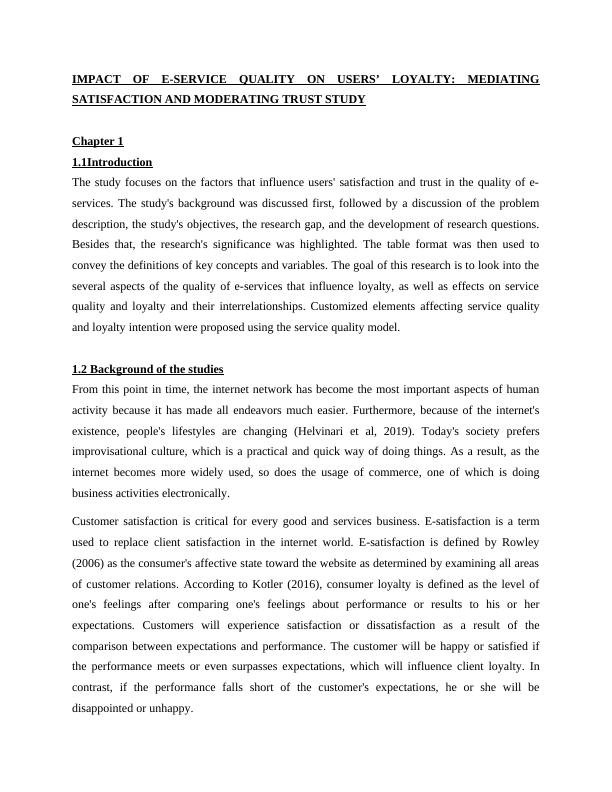
1.3 Justification of Research
Many studies have linked service quality as an indication of customer satisfaction in determining
consumer satisfaction. With the enormous and growing demand for E-Business, it is now more
important than ever have the ability to deliver high-quality service and meet customer
satisfaction, as well as to preserve one's position in the world of e-business in the face of fierce
competition from comparable businesses. According to Helvinasari et al. (2019), the most usual
way to build customer loyalty is to provide quality services or products that are superior to those
of similar competitors. It can also be done by providing the best prices and service that are
relatively affordable and low-cost, or at the very least provide prices that are rather the same as
the competitors.
Customer satisfaction is the most difficult thing for an online business to achieve and maintain.
A service-focused strategy is a critical success factor for surviving in a fiercely competitive e-
environment. Customers must have a positive experience with a company in order for them to
remain loyal to it and repurchase (Gounaris et al,2010). Furthermore, in view of online shopping
experiences in Taiwan, Tsao et al. (2016) investigated the impact of e-service quality on online
loyalty, and it is found that system quality and e-service quality have a significant impact on
perceived value, which in turn has a significant impact on online loyalty.
According to Chang et al. (2013), the most significant component in attracting e-commerce
shoppers is trust. However, there is little research on the influence of service quality on trust,
particularly in the context of internet business. Rasheed and Abadi (2014) investigated the effect
of e-service quality on trust in the services industry as a whole and discovered that trust is a
predictor of service quality.
Many studies have linked service quality as an indication of customer satisfaction in determining
consumer satisfaction. With the enormous and growing demand for E-Business, it is now more
important than ever have the ability to deliver high-quality service and meet customer
satisfaction, as well as to preserve one's position in the world of e-business in the face of fierce
competition from comparable businesses. According to Helvinasari et al. (2019), the most usual
way to build customer loyalty is to provide quality services or products that are superior to those
of similar competitors. It can also be done by providing the best prices and service that are
relatively affordable and low-cost, or at the very least provide prices that are rather the same as
the competitors.
Customer satisfaction is the most difficult thing for an online business to achieve and maintain.
A service-focused strategy is a critical success factor for surviving in a fiercely competitive e-
environment. Customers must have a positive experience with a company in order for them to
remain loyal to it and repurchase (Gounaris et al,2010). Furthermore, in view of online shopping
experiences in Taiwan, Tsao et al. (2016) investigated the impact of e-service quality on online
loyalty, and it is found that system quality and e-service quality have a significant impact on
perceived value, which in turn has a significant impact on online loyalty.
According to Chang et al. (2013), the most significant component in attracting e-commerce
shoppers is trust. However, there is little research on the influence of service quality on trust,
particularly in the context of internet business. Rasheed and Abadi (2014) investigated the effect
of e-service quality on trust in the services industry as a whole and discovered that trust is a
predictor of service quality.

1.4 Problem Statement
Despite the fact that low prices and a strong online presence were once regarded to become the
keys to success, quality of the services issues quickly became critical. The viability of Web
channels was jeopardized when products were not delivered on time, consumers were unable to
complete transactions, requested information could not be obtained, and e-mails were not
replied. A growing body of information from the commercial and academic worlds revealed a
pervasive lack of sufficient service quality supplied via Internet channel (Ahmad 2002).
Customer loyalty should be considered the foundation and nature of any successful relationship
in any area of life, business, and ruling if efficient communication is considered a key to
successful sales (Milad 2014).Without a doubt, in the context of electronic services, they will
make client loyalty one of the most significant and strategic elements (ShirKhodaii, 2005).In
general, one of the most difficult difficulties for every organization is to gain consumers' trust,
improve their satisfaction, and turn them into loyal clients. Due to the novelty of the environment
and the lack of actual contact, building trust with consumers in Internet businesses has become a
key factor for success (Anderson& Srinivasan,2003).
According to a growing statistic of the global trend of web-based business, a key component of
e-services has been approved as an indisputable demand and attract more customers, expand and
diversify their services. Business organizations integrated and coordinated with communication
technologies and information at a quick pace (Milad 2014). Every firm tries to be a leader in this
industry by providing a new electronic service package (Natchaya & Siriluck, 2010). Consumers
who are e-loyal spend more money and have lower operating costs than new customers (Yang et
al, 2004). Since the cost of attracting new consumers is higher than the cost of keeping current
consumers, it is more reasonable as from the Hekmat Iranian Bank case (Milad 2014) to keep
consumers rather than target new customers when providing electronic banking services to
customers. This demonstrates the importance of promoting electronic banking services
(Javanmard & Soltanzade, 2009). The quality of service provided electronically is one of the
elements that might play a significant part for the supplying organization in this sector. As a
result, paying attention to the quality of corporate online services helps build customer loyalty to
these services. As a result, we will investigate the impact of -services quality on customer e-
loyaloty.
Despite the fact that low prices and a strong online presence were once regarded to become the
keys to success, quality of the services issues quickly became critical. The viability of Web
channels was jeopardized when products were not delivered on time, consumers were unable to
complete transactions, requested information could not be obtained, and e-mails were not
replied. A growing body of information from the commercial and academic worlds revealed a
pervasive lack of sufficient service quality supplied via Internet channel (Ahmad 2002).
Customer loyalty should be considered the foundation and nature of any successful relationship
in any area of life, business, and ruling if efficient communication is considered a key to
successful sales (Milad 2014).Without a doubt, in the context of electronic services, they will
make client loyalty one of the most significant and strategic elements (ShirKhodaii, 2005).In
general, one of the most difficult difficulties for every organization is to gain consumers' trust,
improve their satisfaction, and turn them into loyal clients. Due to the novelty of the environment
and the lack of actual contact, building trust with consumers in Internet businesses has become a
key factor for success (Anderson& Srinivasan,2003).
According to a growing statistic of the global trend of web-based business, a key component of
e-services has been approved as an indisputable demand and attract more customers, expand and
diversify their services. Business organizations integrated and coordinated with communication
technologies and information at a quick pace (Milad 2014). Every firm tries to be a leader in this
industry by providing a new electronic service package (Natchaya & Siriluck, 2010). Consumers
who are e-loyal spend more money and have lower operating costs than new customers (Yang et
al, 2004). Since the cost of attracting new consumers is higher than the cost of keeping current
consumers, it is more reasonable as from the Hekmat Iranian Bank case (Milad 2014) to keep
consumers rather than target new customers when providing electronic banking services to
customers. This demonstrates the importance of promoting electronic banking services
(Javanmard & Soltanzade, 2009). The quality of service provided electronically is one of the
elements that might play a significant part for the supplying organization in this sector. As a
result, paying attention to the quality of corporate online services helps build customer loyalty to
these services. As a result, we will investigate the impact of -services quality on customer e-
loyaloty.
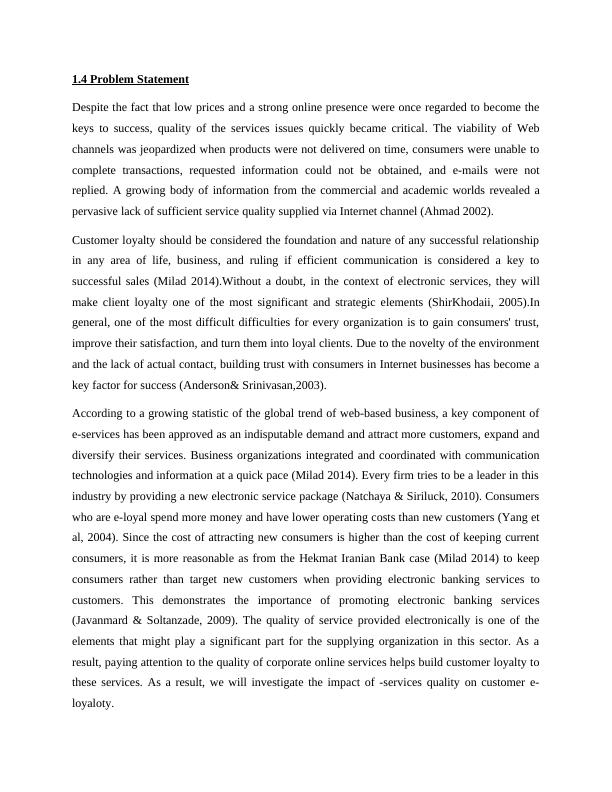
1.5 Gap of the Research
The notion of quality of e-services has been researched by a number of researchers. Overall e-
service quality, repurchase intentions, and consumer happiness all exhibit a substantial
relationship with e-service quality parameters, but not with WOM (Blut et al, 2015). The value
of the quality of e-service attributes would be exaggerated if an inaccurately stated e-service
quality model was used (Blut et al., 2015). This study experimentally investigated Blut et al
(2015) e-services quality model to understand the impact of electronic service quality not only on
consumer satisfaction, purchase intention and word-of-mouth, but also on consumer trust and
website revisiting, in order to resolve the above-mentioned research gaps.
In the research, we found that the relevance of e-services quality is affected by the national
culture (Blut et al, 2015). In order to see if the hierarchical model of e-service quality
measurement works equally effective in different countries and cultures, this study empirically
examined it in a new cultural setting, in the context of Indonesia. Cultural differences in online
shopping behavior may affect the priority of e-services quality attributes, but this remains to be
researched (Brusch et al, 2019).
There are some flaws in the current measuring of the quality of e-services in online business. E-
S-Qual and eTailQ metrics, according to Blut (2016), lack criteria for evaluating online retailers,
therefore they can't adequately clarify customer discontent and moving to alternative online
services. The capacity to forecast client behavior is the other flaw. eTailQ ranks seventh in its
predictive abilities and does not do well in measuring security and customer service, despite
covering 13 of 16 aspects of e-service quality (Blut et al., 2015). WebQual may be the best at
predicting customer behavior, but it only focuses on one thing(Paulo et al, 2019).There are just a
few studies that have looked into the relationship between experience domains (education,
escapism, aesthetics, and entertainment) and consumer satisfaction in the context of online
services(Alan & Yasin ,2010).According to Tandon and Kiran (2019), website quality (e.g.
security and privacy, simplicity of ordering, product customization, ease of navigating, and
website design), which is an aesthetic component, has a considerable impact on user satisfaction.
The notion of quality of e-services has been researched by a number of researchers. Overall e-
service quality, repurchase intentions, and consumer happiness all exhibit a substantial
relationship with e-service quality parameters, but not with WOM (Blut et al, 2015). The value
of the quality of e-service attributes would be exaggerated if an inaccurately stated e-service
quality model was used (Blut et al., 2015). This study experimentally investigated Blut et al
(2015) e-services quality model to understand the impact of electronic service quality not only on
consumer satisfaction, purchase intention and word-of-mouth, but also on consumer trust and
website revisiting, in order to resolve the above-mentioned research gaps.
In the research, we found that the relevance of e-services quality is affected by the national
culture (Blut et al, 2015). In order to see if the hierarchical model of e-service quality
measurement works equally effective in different countries and cultures, this study empirically
examined it in a new cultural setting, in the context of Indonesia. Cultural differences in online
shopping behavior may affect the priority of e-services quality attributes, but this remains to be
researched (Brusch et al, 2019).
There are some flaws in the current measuring of the quality of e-services in online business. E-
S-Qual and eTailQ metrics, according to Blut (2016), lack criteria for evaluating online retailers,
therefore they can't adequately clarify customer discontent and moving to alternative online
services. The capacity to forecast client behavior is the other flaw. eTailQ ranks seventh in its
predictive abilities and does not do well in measuring security and customer service, despite
covering 13 of 16 aspects of e-service quality (Blut et al., 2015). WebQual may be the best at
predicting customer behavior, but it only focuses on one thing(Paulo et al, 2019).There are just a
few studies that have looked into the relationship between experience domains (education,
escapism, aesthetics, and entertainment) and consumer satisfaction in the context of online
services(Alan & Yasin ,2010).According to Tandon and Kiran (2019), website quality (e.g.
security and privacy, simplicity of ordering, product customization, ease of navigating, and
website design), which is an aesthetic component, has a considerable impact on user satisfaction.
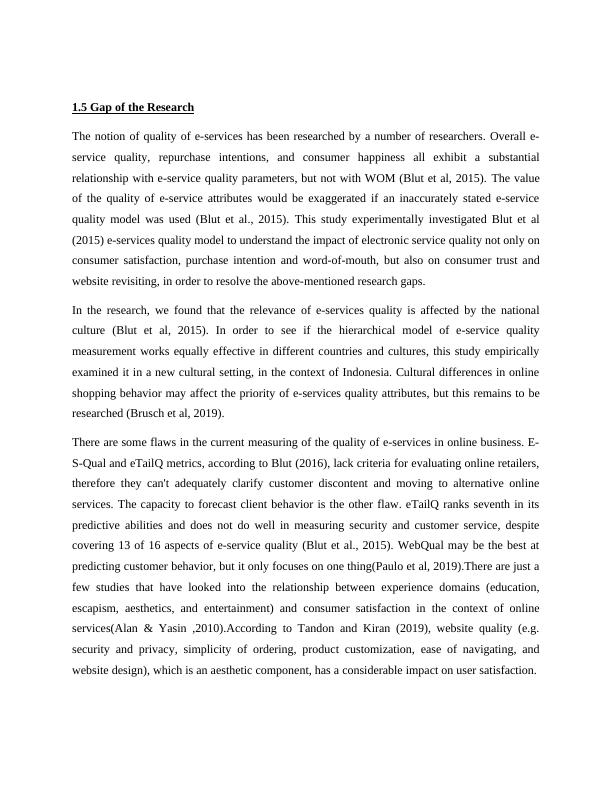
1.6 Research Question
Main Question: What are the determinants of Users’ Loyalty towards e-service quality?
Specific Questions:
1) What is the relationship between satisfaction and loyalty?
2) What is the relationship between trust and loyalty?
3) What is the relationship between E-service Quality and Satisfaction?
4) What is the relationship between E-service Quality and Trust?
5) What is the relationship between Web Design and E-service Quality?
6) What is the relationship between System Quality and E-service Quality?
7) What is the relationship between Security and E-service Quality?
1.7 Research Objectives
As the main purpose of this research is to determine the effect of satisfaction and trust towards
customer loyalty towards the e-service quality. To complete this, objectives were listed:
1) To determine the determinants of Users Loyalty towards e-service quality.
2) To evaluate the relationship between satisfaction and loyalty.
3) To study the relationship between trust and loyalty.
4) To examine the relationship between E-service Quality and Satisfaction.
5) To examine the relationship between E-service Quality and Trust.
6) To examine the relationship between Web Design and E-service Quality.
7) To evaluate the relationship between System Quality and E-service Quality.
8) To study the relationship between Security and E-Service Quality.
1.8 Conclusion
This chapter provided a summary of the entire study as a stepping stone to the next several
Chapters. The reader's attention is drawn to the research aims and research questions after
Main Question: What are the determinants of Users’ Loyalty towards e-service quality?
Specific Questions:
1) What is the relationship between satisfaction and loyalty?
2) What is the relationship between trust and loyalty?
3) What is the relationship between E-service Quality and Satisfaction?
4) What is the relationship between E-service Quality and Trust?
5) What is the relationship between Web Design and E-service Quality?
6) What is the relationship between System Quality and E-service Quality?
7) What is the relationship between Security and E-service Quality?
1.7 Research Objectives
As the main purpose of this research is to determine the effect of satisfaction and trust towards
customer loyalty towards the e-service quality. To complete this, objectives were listed:
1) To determine the determinants of Users Loyalty towards e-service quality.
2) To evaluate the relationship between satisfaction and loyalty.
3) To study the relationship between trust and loyalty.
4) To examine the relationship between E-service Quality and Satisfaction.
5) To examine the relationship between E-service Quality and Trust.
6) To examine the relationship between Web Design and E-service Quality.
7) To evaluate the relationship between System Quality and E-service Quality.
8) To study the relationship between Security and E-Service Quality.
1.8 Conclusion
This chapter provided a summary of the entire study as a stepping stone to the next several
Chapters. The reader's attention is drawn to the research aims and research questions after
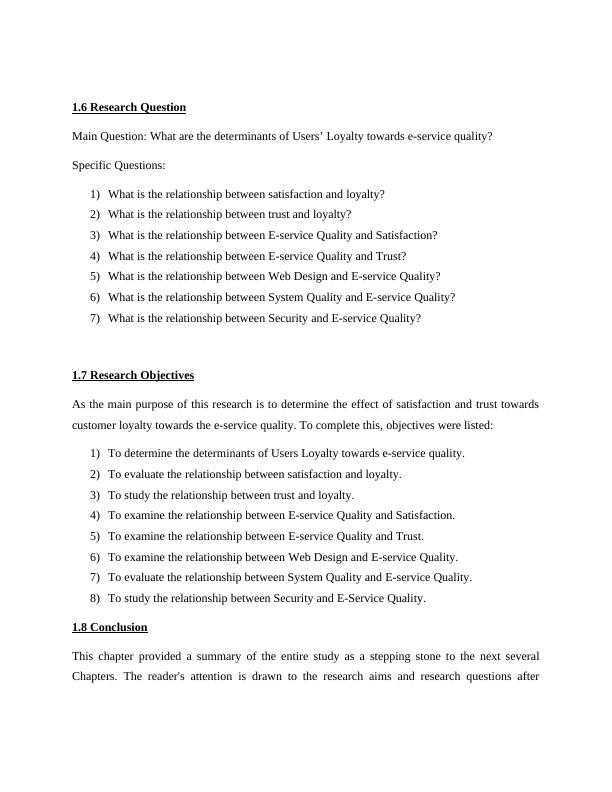
explaining the study's background and stressing the problem statement. The chapters that follow
will go through existing research and how to formulate hypotheses for this study.
Chapter 2
2.0 Introduction
In this chapter, the determinants of customer loyalty on the e-service quality, for acquiring the
understanding in the motivating process that can affect the user’s loyalty from e-service quality,
the mediating impact of e-service quality on consumer satisfaction was mentioned. As the
moderating effect of Trust is constructed for gaining a better insight of the motivation process
which also influenced the user’s loyalty on the e-service quality.
The first part for this chapter will be discussing the theoretical framework that will be adopted in
this research which is the SOR model. In addition, all the variables that related in this study was
discussed detailly including mediating variables and moderating variables. The variables are
Loyalty, Satisfaction, Trust, Web design, system quality, and Security. Furthermore, the
hypotheses of this study will be developed as to determine the relationship between independent
variables and dependent variables, as also including the mediating variable and moderating
variable. Lastly, the conceptual framework of this research is presented in diagram with
description.
2.1 E-Service Quality
Zeithmal et al (2002) provide one of the simplest definitions of e-service quality. E-service
quality, in the opinion of these authors, is a sphere in which users can receive efficient and
effective services via electronic media. In their study, Parasuraman and colleagues (2005) found
that consumers' views of service quality in electronic media differ significantly from those in
conventional media, because people's beliefs and perceptions about technology influence their
acceptance and application of technology. Furthermore, the trait of efficiently and effectively
meeting client requests is referred to as e-service quality (Fenglin & Zakson, 2008). According to
will go through existing research and how to formulate hypotheses for this study.
Chapter 2
2.0 Introduction
In this chapter, the determinants of customer loyalty on the e-service quality, for acquiring the
understanding in the motivating process that can affect the user’s loyalty from e-service quality,
the mediating impact of e-service quality on consumer satisfaction was mentioned. As the
moderating effect of Trust is constructed for gaining a better insight of the motivation process
which also influenced the user’s loyalty on the e-service quality.
The first part for this chapter will be discussing the theoretical framework that will be adopted in
this research which is the SOR model. In addition, all the variables that related in this study was
discussed detailly including mediating variables and moderating variables. The variables are
Loyalty, Satisfaction, Trust, Web design, system quality, and Security. Furthermore, the
hypotheses of this study will be developed as to determine the relationship between independent
variables and dependent variables, as also including the mediating variable and moderating
variable. Lastly, the conceptual framework of this research is presented in diagram with
description.
2.1 E-Service Quality
Zeithmal et al (2002) provide one of the simplest definitions of e-service quality. E-service
quality, in the opinion of these authors, is a sphere in which users can receive efficient and
effective services via electronic media. In their study, Parasuraman and colleagues (2005) found
that consumers' views of service quality in electronic media differ significantly from those in
conventional media, because people's beliefs and perceptions about technology influence their
acceptance and application of technology. Furthermore, the trait of efficiently and effectively
meeting client requests is referred to as e-service quality (Fenglin & Zakson, 2008). According to
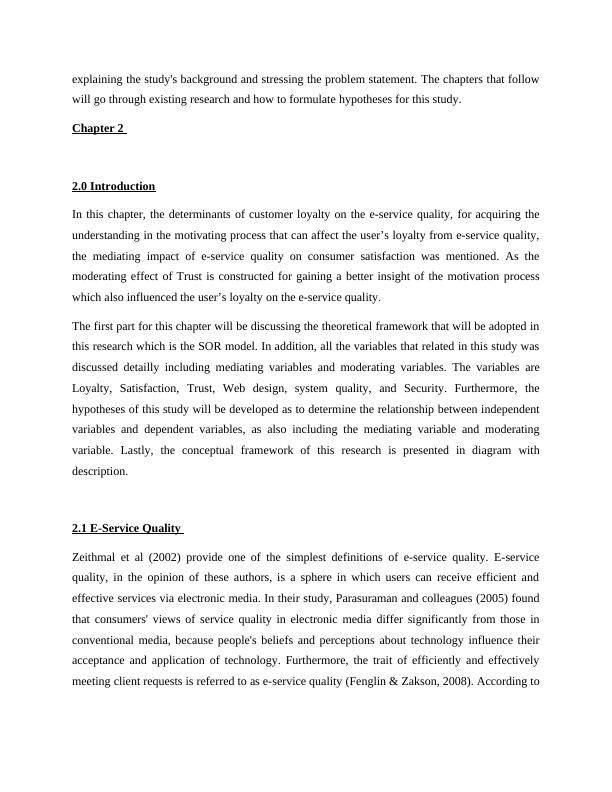
Santos (2003), e-service quality refers to customers' overall views, judgments, and evaluations of
services that will be provided via electronic media (Edwu et al, 2010).
E-services quality recommendation takes the pragmatic interpretation of quality and customer
satisfaction as the most important criterion for verifying the level of service quality (Milad
2014). A high level of services quality can be regarded as a competitive advantage, and
customers must set the expected level of service quality. Consumer knowledge of the services
supplied by businesses, as well as standards connected to their expectations of the service, has
increased in recent years (Abtahi & Meratnia, 2008). According to Parasuraman et al. (2002), It
has two keys benefits of e-services which is transactional output and informational output. As a
result, it is unsurprising that online clients are drawn to the virtual world in search of these two
traits (Barrutia & Gilsanse, 2009).
2.2 Theory (SOR model)
From environmental psychology, Russell and Mehrabian (1974) proposed Stimulus-Organism-
Response (S-O-R) [15]. The SOR framework assumes that input has an effect on an individual's
emotional state. This internal processing includes the personal cognitive and emotional
responses, such as stimulus perception and responses, which can prove SOR in both intangible
and physical form. SOR uses environmental cues to stimulate personal cognitive and emotional
state, resulting in certain behavioral consequences (Chan et al,2017). In the study of consumer
behavior, the SOR model is useful for distinguishing inputs from users' internal and outward
actions. As a result, the S-O-R framework is a well-known psychological theory in consumer
behavior research (Chang et al,2011).
The goal of this study is to study consumers' e-service quality consumption behavior based on
their emotional and cognitive responses using the SOR framework (Su et al,2019), where the
stimulus components are Web Designs, System Quality, and Security. This assist in elucidating
what causes users to be exposed to situational stimuli (Su et al, 2019) in their perception of e-
service consumption. The term "organism" refers to the users' cognitive and emotional state, as
well as their perspectives, assessments, and experiences, and the satisfaction and trust factor
chosen in this study. Finally, user loyalty is referred to as response. The study by Hossain et al.
services that will be provided via electronic media (Edwu et al, 2010).
E-services quality recommendation takes the pragmatic interpretation of quality and customer
satisfaction as the most important criterion for verifying the level of service quality (Milad
2014). A high level of services quality can be regarded as a competitive advantage, and
customers must set the expected level of service quality. Consumer knowledge of the services
supplied by businesses, as well as standards connected to their expectations of the service, has
increased in recent years (Abtahi & Meratnia, 2008). According to Parasuraman et al. (2002), It
has two keys benefits of e-services which is transactional output and informational output. As a
result, it is unsurprising that online clients are drawn to the virtual world in search of these two
traits (Barrutia & Gilsanse, 2009).
2.2 Theory (SOR model)
From environmental psychology, Russell and Mehrabian (1974) proposed Stimulus-Organism-
Response (S-O-R) [15]. The SOR framework assumes that input has an effect on an individual's
emotional state. This internal processing includes the personal cognitive and emotional
responses, such as stimulus perception and responses, which can prove SOR in both intangible
and physical form. SOR uses environmental cues to stimulate personal cognitive and emotional
state, resulting in certain behavioral consequences (Chan et al,2017). In the study of consumer
behavior, the SOR model is useful for distinguishing inputs from users' internal and outward
actions. As a result, the S-O-R framework is a well-known psychological theory in consumer
behavior research (Chang et al,2011).
The goal of this study is to study consumers' e-service quality consumption behavior based on
their emotional and cognitive responses using the SOR framework (Su et al,2019), where the
stimulus components are Web Designs, System Quality, and Security. This assist in elucidating
what causes users to be exposed to situational stimuli (Su et al, 2019) in their perception of e-
service consumption. The term "organism" refers to the users' cognitive and emotional state, as
well as their perspectives, assessments, and experiences, and the satisfaction and trust factor
chosen in this study. Finally, user loyalty is referred to as response. The study by Hossain et al.
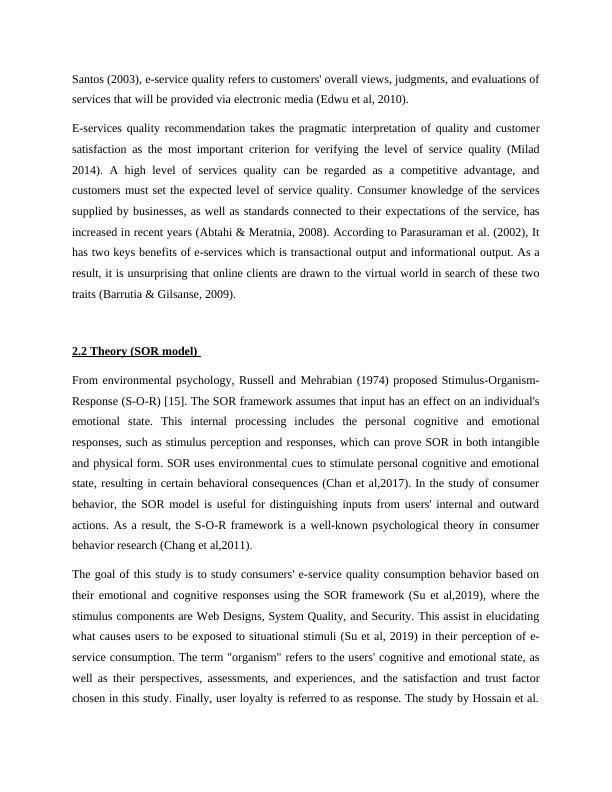
(2018) use SOR as the only research that uses SOR as a research framework to understand the
usage intention and satisfaction of electronic services.
2.3 Dependent Variable (Loyalty)
Many scholars have examined and defined the topic of loyalty using different dimensions.
According to Edvardsson et al. (2000), loyalty is defined as a consumer’s intention or
willingness to utilize the same company's services again. Loyalty has been identified as a factor
in a company's long-term performance (Flavian et al., 2006). Self-efficacy, contentment, and
service experience were found as the key antecedents of user loyalty in Thakur's (2018) study on
mobile shopping apps. According to Gross (2018), users' loyalty is determined by social value,
trust, and satisfaction. Thakur (2014) looked at consumer loyalty in the context of a mobile
banking app, and found that mobile banking satisfaction has a positive impact on user loyalty.
Baabdullah et al. (2019) investigated the primary elements influencing user loyalty in Saudi
Arabia, finding that user satisfaction and behavior have a significant impact on loyalty.
O'Malley (1998) proposes a four-stage loyalty model, which divides loyalty into four categories
based on the stages of attitude development. These four stages look at how service quality,
customer satisfaction, and loyalty are linked. Consumers have a preference of a certain company
or brand over other options in the delivery of service quality in the initial loyalty phase, referred
to as cognitive loyalty. When users are satisfied, affection surges in, and they enter the affective
loyalty phase. Customers develop a liking and favorable attitude toward the company or brand as
a result of a positive encounter with it, just as they did in the second phase. Customers will enter
the conative loyalty phase after experiencing ongoing favorable effects, where they have the
intention and commitment to repurchase. The last phase is the loyalty phase, in which customers
have a strong desire to repeatedly re use intention from a favorite firm or brand, as well as a
desire to overcome any obstacles that may prevent them from doing so.
2.4.1 Independent Variable (Web Design)
usage intention and satisfaction of electronic services.
2.3 Dependent Variable (Loyalty)
Many scholars have examined and defined the topic of loyalty using different dimensions.
According to Edvardsson et al. (2000), loyalty is defined as a consumer’s intention or
willingness to utilize the same company's services again. Loyalty has been identified as a factor
in a company's long-term performance (Flavian et al., 2006). Self-efficacy, contentment, and
service experience were found as the key antecedents of user loyalty in Thakur's (2018) study on
mobile shopping apps. According to Gross (2018), users' loyalty is determined by social value,
trust, and satisfaction. Thakur (2014) looked at consumer loyalty in the context of a mobile
banking app, and found that mobile banking satisfaction has a positive impact on user loyalty.
Baabdullah et al. (2019) investigated the primary elements influencing user loyalty in Saudi
Arabia, finding that user satisfaction and behavior have a significant impact on loyalty.
O'Malley (1998) proposes a four-stage loyalty model, which divides loyalty into four categories
based on the stages of attitude development. These four stages look at how service quality,
customer satisfaction, and loyalty are linked. Consumers have a preference of a certain company
or brand over other options in the delivery of service quality in the initial loyalty phase, referred
to as cognitive loyalty. When users are satisfied, affection surges in, and they enter the affective
loyalty phase. Customers develop a liking and favorable attitude toward the company or brand as
a result of a positive encounter with it, just as they did in the second phase. Customers will enter
the conative loyalty phase after experiencing ongoing favorable effects, where they have the
intention and commitment to repurchase. The last phase is the loyalty phase, in which customers
have a strong desire to repeatedly re use intention from a favorite firm or brand, as well as a
desire to overcome any obstacles that may prevent them from doing so.
2.4.1 Independent Variable (Web Design)
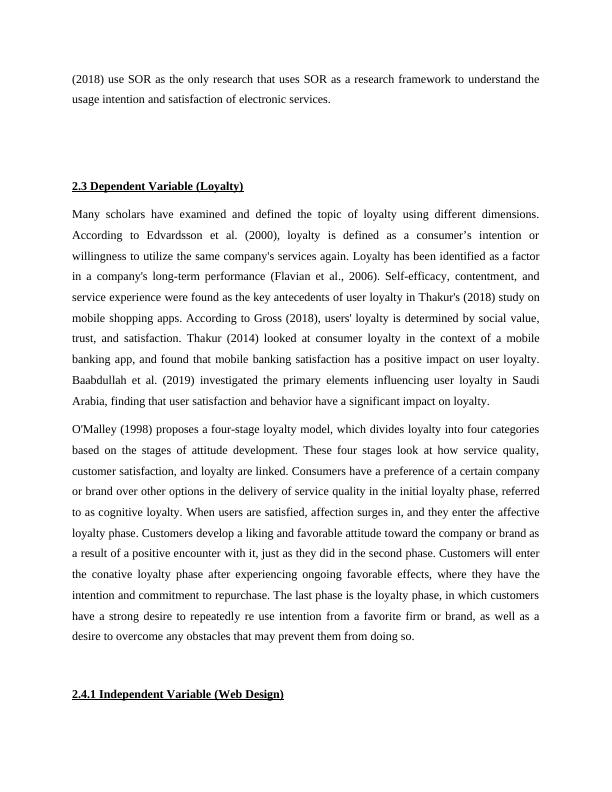
End of preview
Want to access all the pages? Upload your documents or become a member.
Related Documents
Impact of Customer Perceived Value on Customer Satisfaction and Loyalty in Food Industry of Hong Konglg...
|19
|5100
|259
Business Integration Project Reportlg...
|32
|6585
|79
Journal Of Sociological Research 2022lg...
|23
|10008
|77
(PDF) Effect of Website Quality on E-satisfactionlg...
|13
|2088
|508
Impact of Customer Satisfaction on Brand Loyaltylg...
|1
|2438
|66
Internet marketinglg...
|6
|297
|399
